NCERT Solutions for Class 9 Maths Chapter 8 Exercise 8.1 - Quadrilaterals
A polygon is a geometrical figure that is defined by straight lines. A quadrilateral is a polygon that has four sides. The types of quadrilaterals are determined by the angles and lengths of their sides. Because the word "quad" means "four," all of these quadrilaterals have four sides, and the sum of their angles is 360 degrees. Types of quadrilaterals are Squares, Trapeziums, Parallelogram, Rectangle, Rhombus, and Kite. Some points to be noted about the types of quadrilaterals are: A square can likewise be considered a rectangle and a rhombus, yet every rectangle or rhombus is not a square. A trapezium isn't a parallelogram (as just one set of inverse sides are equal in a trapezium, and we require the two sets to be equal in a parallelogram)
This Story also Contains
- NCERT Solutions for Class 9 Maths Chapter 8 Quadrilaterals Exercise 8.1
- Access Quadrilaterals Class 9 Chapter 8 Exercise: 8.1
- Topics covered in Chapter 8, Quadrilateral: Exercise 8.1
- NCERT Solutions of Class 9 Subject Wise
- Subject-Wise NCERT Exemplar Solutions

Along with Class 9 Maths, chapter 8, exercise 8.1, the following exercises are also present in the NCERT book. This class 9 Maths chapter 8 exercise 8.1 focuses on quadrilaterals, four-sided shapes. Exercise 8.1 helps you understand their basics, properties, and types. Our free PDF for NCERT solutions simplify complex ideas, providing clear explanations and step-by-step guidance. These resources aid your understanding, exam preparation, and math success.
Access Quadrilaterals Class 9 Chapter 8 Exercise: 8.1
Q1. If the diagonals of a parallelogram are equal, then show that it is a rectangle.
Solution:
Given: ABCD is a parallelogram with AC = BD.
To prove: ABCD is a rectangle.
Proof: In △ ABC and △ BAD,

BC = AD (Opposite sides of a parallelogram)
AC = BD (Given)
AB = AB (Common)
△ ABC ≅ △ BAD (By SSS)
∠ABC=∠BAD (CPCT)
And ∠ABC+∠BAD=180∘ (Co - interior angles)
2∠BAD=180∘
∠BAD=90∘
Hence, it is a rectangle.
Q2. Show that the diagonals of a square are equal and bisect each other at right angles.

Solution:
Given: ABCD is a square, i.e. AB = BC = CD = DA.
To prove: the diagonals of a square are equal and bisect each other at right angles i.e. AC = BD, AO = CO, BO = DO and ∠COD=90∘
Proof: In △ BAD and △ ABC,
∠BAD=∠ABC (Each 90∘)
AD = BC (Given)
AB = AB (Common)
△ BAD ≅ △ ABC (By SAS)
BD = AC (CPCT)
In △ AOB and △ COD,
∠ OAB= ∠ OCD (Alternate angles)
AB = CD (Given)
∠ OBA= ∠ ODC (Alternate angles)
△ AOB ≅ △ COD (By AAS)
AO = OC, BO = OD (CPCT)
In △ AOB and △ AOD,
OB = OD (proved above)
AB = AD (Given)
OA = OA (Common)
△ AOB ≅ △ AOD (By SSS)
∠ AOB = ∠ AOD (CPCT)
∠ AOB+ ∠ AOD = 180∘
2∠ AOB = 180∘
∠ AOB = 90∘
Hence, the diagonals of a square are equal and bisect each other at right angles.
Q3 (i) Diagonal AC of a parallelogram ABCD bisects ∠A (see Fig. 8.19 ). Show that it bisects ∠C also.

Solution:
Given: ∠ DAC= ∠ BAC ..........(1)
∠ DAC= ∠ BCA.............(2) (Alternate angles)
∠ BAC= ∠ ACD .............(3) (Alternate angles)
From equations (1), (2) and (3), we get
∠ ACD= ∠ BCA...............(4)
Hence, diagonal AC bisect angle C also.
Q3 (ii) Diagonal AC of a parallelogram ABCD bisects ∠A (see Fig. 8.19 ). Show that ABCD is a rhombus.
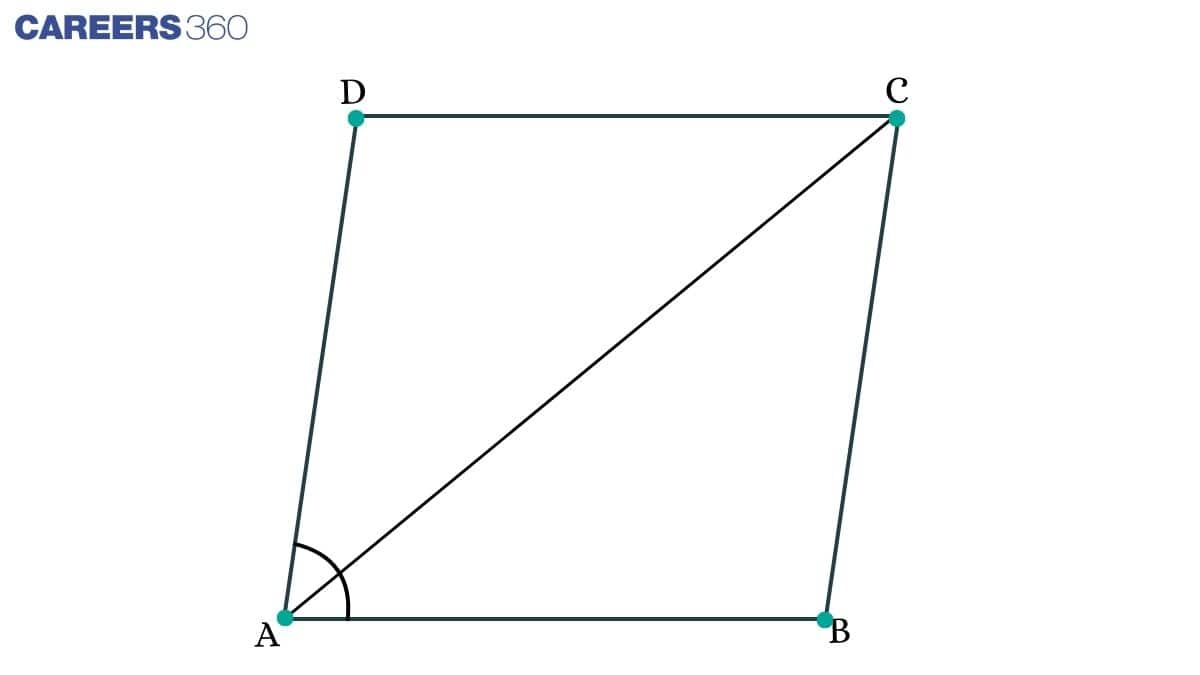
Solution:
Given: ∠ DAC= ∠ BAC .............(1)
∠ DAC= ∠ BCA..............(2) (Alternate angles)
∠ BAC= ∠ ACD ..............(3) (Alternate angles)
From equations (1), (2), and (3), we get
∠ ACD= ∠ BCA..............(4)
From 2 and 4, we get
∠ ACD= ∠ DAC
In △ ADC,
∠ ACD= ∠ DAC (proved above)
AD = DC (In a triangle, sides opposite to equal angles are equal)
A parallelogram whose adjacent sides are equal is a rhombus.
Thus, ABCD is a rhombus.
Q4 (i) ABCD is a rectangle in which diagonal AC bisects ∠A as well as ∠C . Show that: ABCD is a square
Solution:

Given: ABCD is a rectangle with AB=CD and BC=AD ∠ 1= ∠ 2 and ∠ 3= ∠ 4.
To prove: ABCD is a square.
Proof : ∠ 1= ∠ 4 ............(1)(Alternate angles)
∠ 3= ∠ 4 ..............(2)(Given )
From 1 and 2, ∠ 1= ∠ 3.......................(3)
In △ ADC,
∠ 1= ∠ 3 (From 3 )
DC = AD (In a triangle, sides opposite to equal angles are equal)
A rectangle whose adjacent sides are equal is a square.
Hence, ABCD is a square.
Q4 (ii) ABCD is a rectangle in which diagonal AC bisects ∠A as well as ∠C . Show that: diagonal BD bisects ∠B as well as ∠D .
Solution:
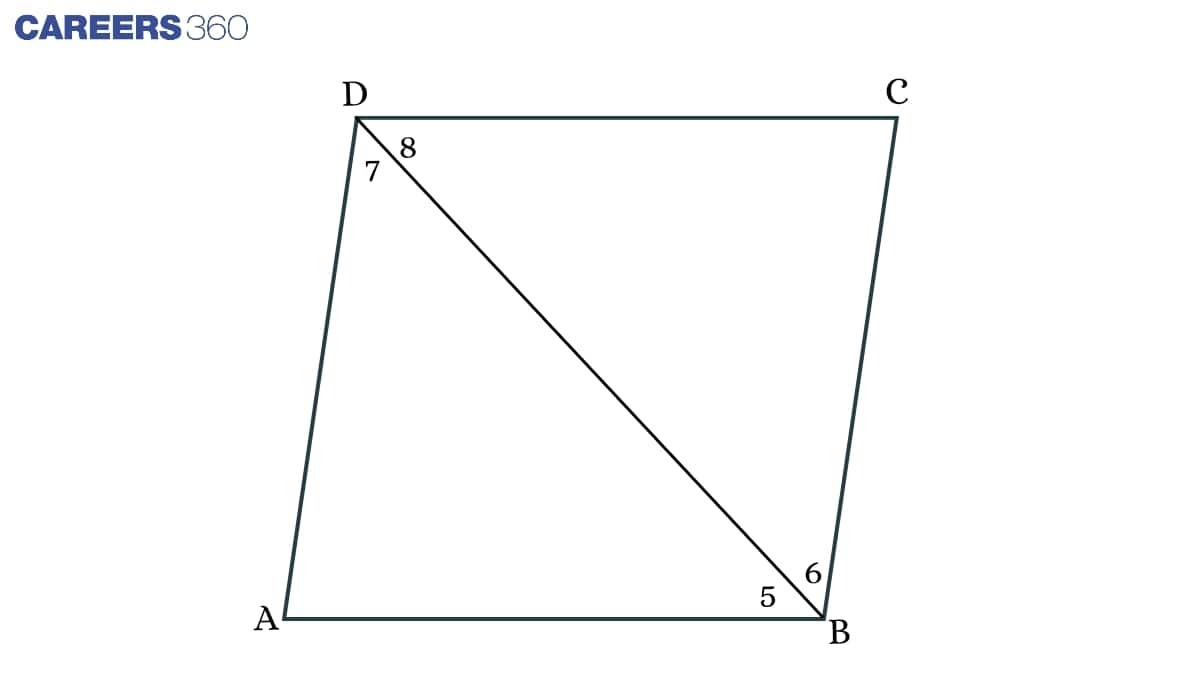
In △ ADB,
AD = AB (ABCD is a square)
∠ 5= ∠ 7...............(1) (Angles opposite to equal sides are equal)
∠ 5= ∠ 8...............(2) (Alternate angles)
From (1) and (2), we have
∠ 7= ∠ 8.............(3)
And ∠ 7 = ∠ 6.................4(Alternate angles)
From (1) and (4), we get
∠ 5= ∠ 6..............(5)
Hence, from 3 and 5, diagonal BD bisects angles B as well as angle D.

Solution:
Given: In parallelogram ABCD, two points P and Q are taken on diagonal BD such that DP=BQ.
To prove : ΔAPD≅ΔCQB
Proof:
In ΔAPDandΔCQB,
DP=BQ (Given)
∠ ADP= ∠ CBQ (Alternate angles)
AD = BC (Opposite sides of a parallelogram)
ΔAPD≅ΔCQB (By SAS)
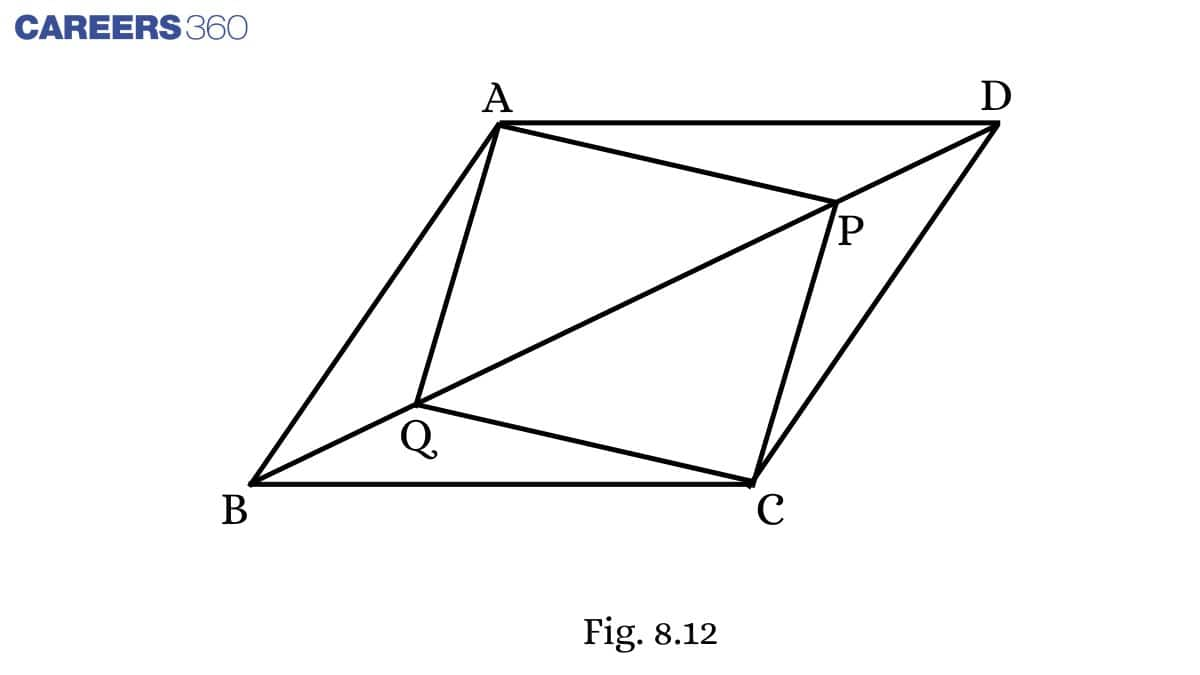
Solution:
Given: In parallelogram ABCD, two points P and Q are taken on diagonal BD such that DP=BQ.
To prove: AP=CQ
Proof:
In ΔAPDandΔCQB,
DP=BQ (Given)
∠ ADP= ∠ CBQ (Alternate angles)
AD = BC (Opposite sides of a parallelogram)
ΔAPD≅ΔCQB (By SAS)
AP=CQ (CPCT)

Solution:
Given: In parallelogram ABCD, two points P and Q are taken on diagonal BD such that DP=BQ.
To prove: ΔAQB≅ΔCPD
Proof:
In ΔAQBandΔCPD,
DP = BQ (Given)
∠ ABQ= ∠ CDP (Alternate angles)
AB = CD (Opposite sides of a parallelogram)
ΔAQB≅ΔCPD (By SAS)
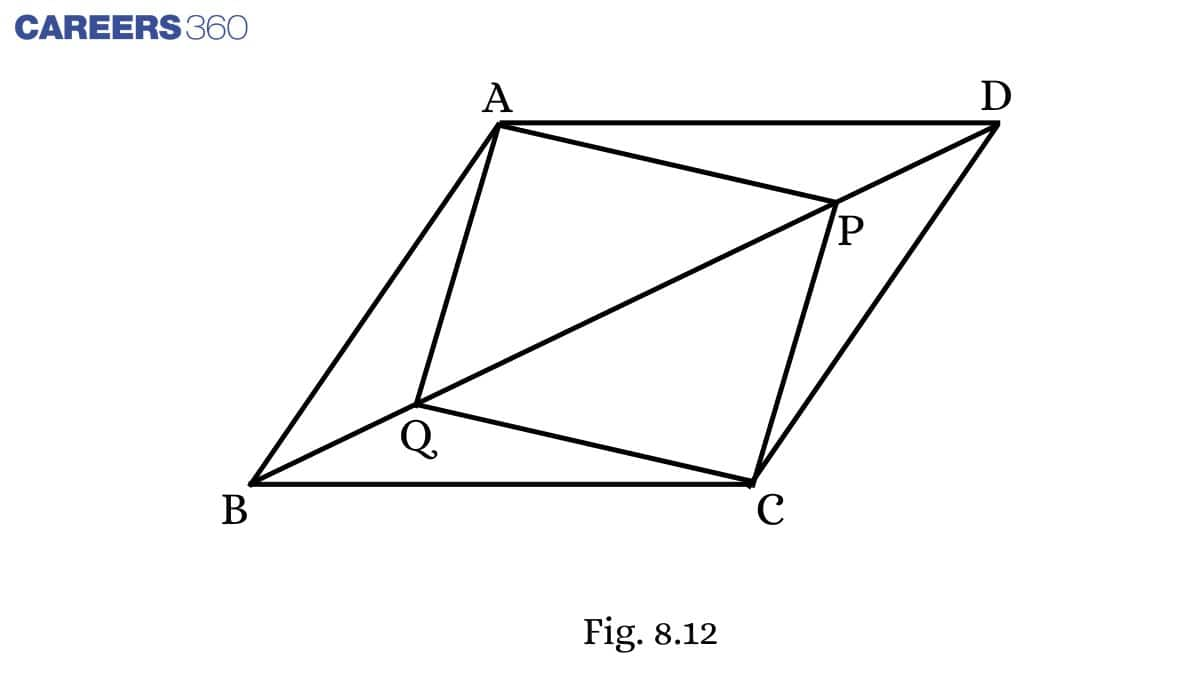
Solution:
Given: In parallelogram ABCD, two points P and Q are taken on diagonal BD such that DP=BQ.
To prove: AQ=CP
Proof:
In ΔAQBandΔCPD,
DP = BQ (Given)
∠ ABQ= ∠ CDP (Alternate angles)
AB = CD (Opposite sides of a parallelogram)
ΔAQB≅ΔCPD (By SAS)
AQ=CP (CPCT)
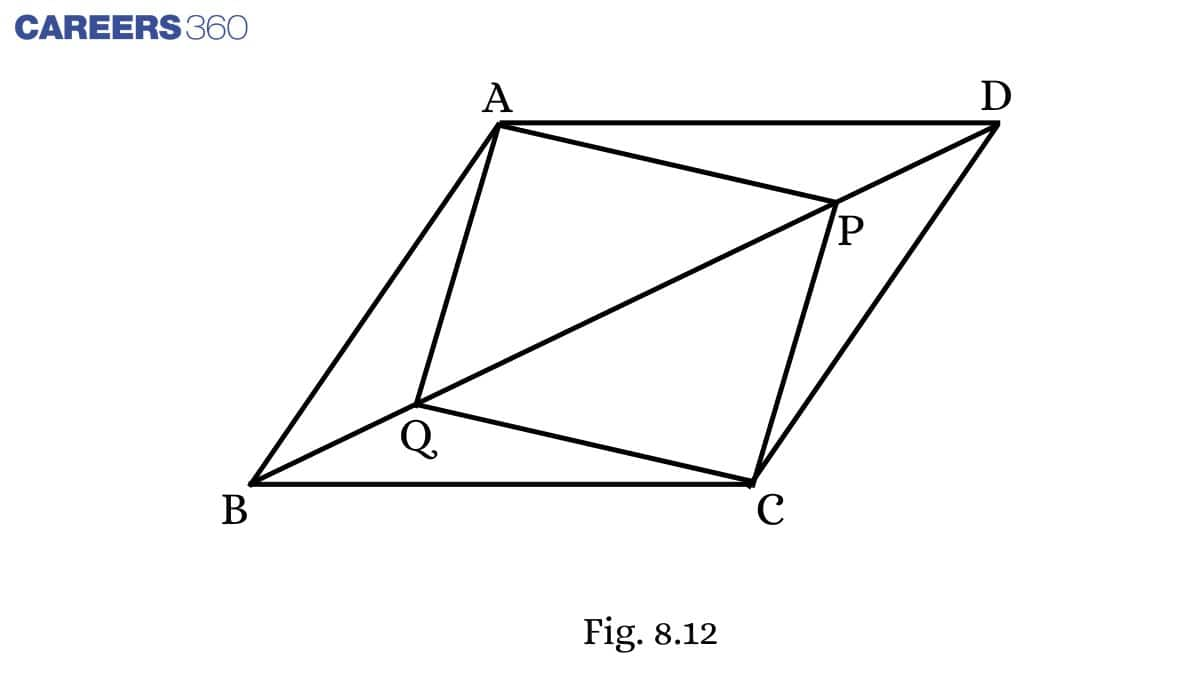
Solution:
Given: In parallelogram ABCD, two points P and Q are taken on diagonal BD such that DP=BQ.
To prove: APCQ is a parallelogram
Proof:
In ΔAPDandΔCQB,
DP = BQ (Given)
∠ ADP= ∠ CBQ (alternate angles)
AD = BC (Opposite sides of a parallelogram)
ΔAPD≅ΔCQB (By SAS)
AP=CQ (CPCT)..............(1)
Also,
In ΔAQBandΔCPD,
DP = BQ (Given)
∠ ABQ= ∠ CDP (Alternate angles)
AB = CD (Opposite sides of a parallelogram)
ΔAQB≅ΔCPD (By SAS)
AQ=CP (CPCT)................(2)
From equations 1 and 2, we get
AP=CQ
AQ=CP
Thus, opposite sides of quadrilateral APCQ are equal, so APCQ is a parallelogram.

Solution:
Given: ABCD is a parallelogram and AP and CQ are perpendiculars from vertices A and C on diagonal BD.
To prove: ΔAPB≅ΔCQD
Proof: In ΔAPBandΔCQD,
∠ APB= ∠ CQD (Each 90∘)
∠ ABP= ∠ CDQ (Alternate angles)
AB = CD (Opposite sides of a parallelogram)
Thus, ΔAPB≅ΔCQD (By SAS)
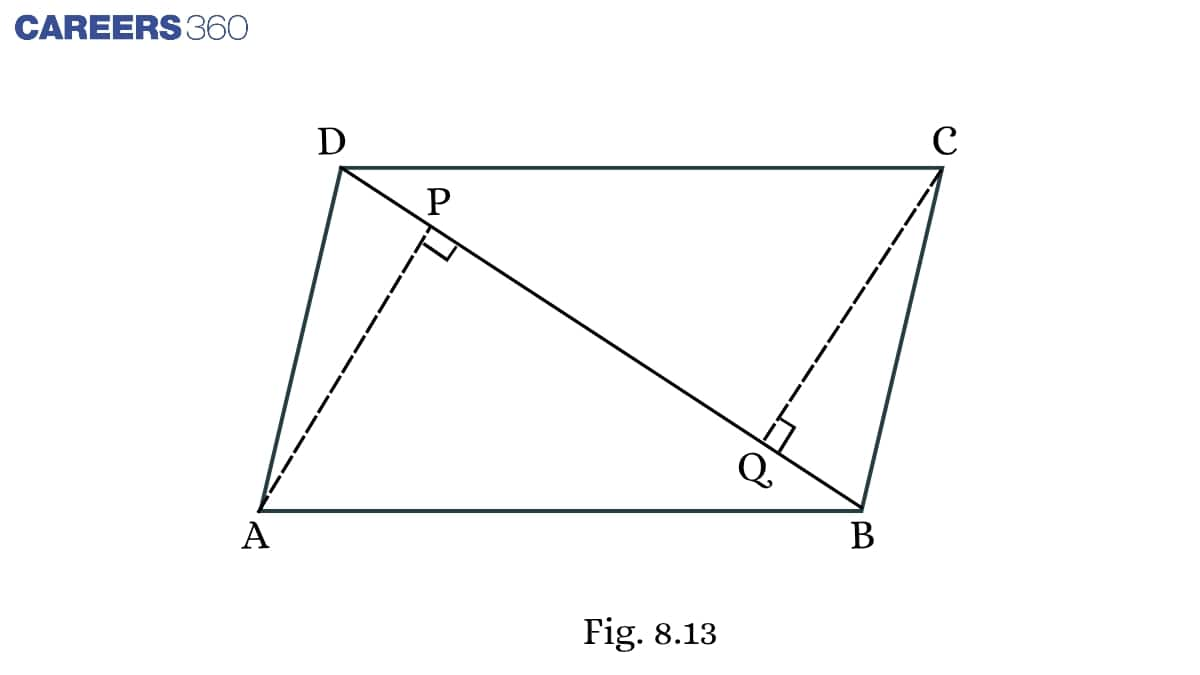
Solution:
Given: ABCD is a parallelogram and AP and CQ are perpendiculars from vertices A and C on diagonal BD.
To prove: AP=CQ
Proof: In ΔAPBandΔCQD,
∠ APB= ∠ CQD (Each 90∘)
∠ ABP= ∠ CDQ (Alternate angles)
AB = CD (Opposite sides of a parallelogram )
Thus, ΔAPB≅ΔCQD (By SAS)
AP=CQ (CPCT)
Q7 (i) ABCD is a trapezium in which AB∥CD and AD=BC (see Fig. 8.14 ). Show that ∠A=∠B
[ Hint: Extend AB and draw a line through C parallel to DA intersecting AB produced at E.]
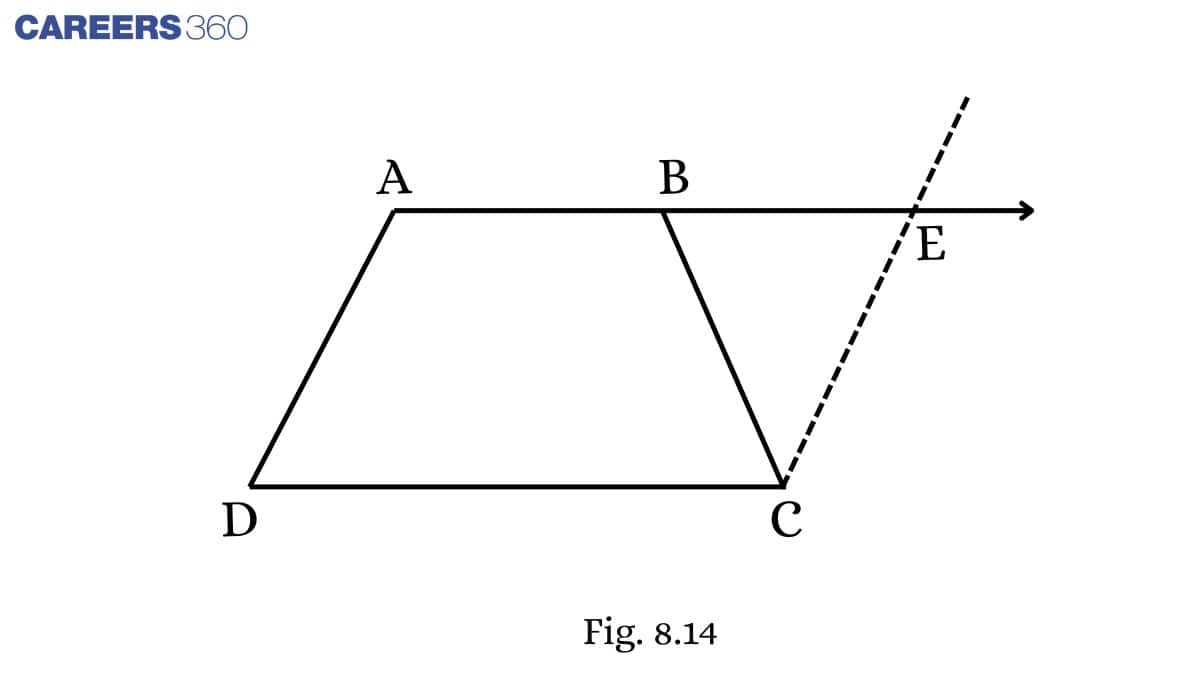
Solution:
Given: ABCD is a trapezium in which AB∥CD and AD=BC
To prove: ∠A=∠B
Proof: Let ∠ A be ∠ 1, ∠ ABC be ∠ 2, ∠ EBC be ∠ 3, ∠ BEC be ∠ 4.
In AECD,
AE || DC (Given)
AD || CE (By construction)
Hence, AECD is a parallelogram.
AD = CE.........(1) (Opposite sides of a parallelogram)
AD = BC...........(2) (Given)
From (1) and (2), we get
CE = BC
In △ BCE,
∠3=∠4 ...............(3) (Opposite angles of equal sides)
∠2+∠3=180∘ ..............(4) (Linear pairs)
∠1+∠4=180∘ ...............(5) (Co-interior angles)
From (4) and (5), we get
∠2+∠3=∠1+∠4
∴∠2=∠1→∠B=∠A (Since, ∠3=∠4 )
Q7 (ii) ABCD is a trapezium in which AB || CD and AD = BC (see Fig. 8.23). Show that ∠C=∠D [Hint: Extend AB and draw a line through C parallel to DA intersecting AB produced at E.]
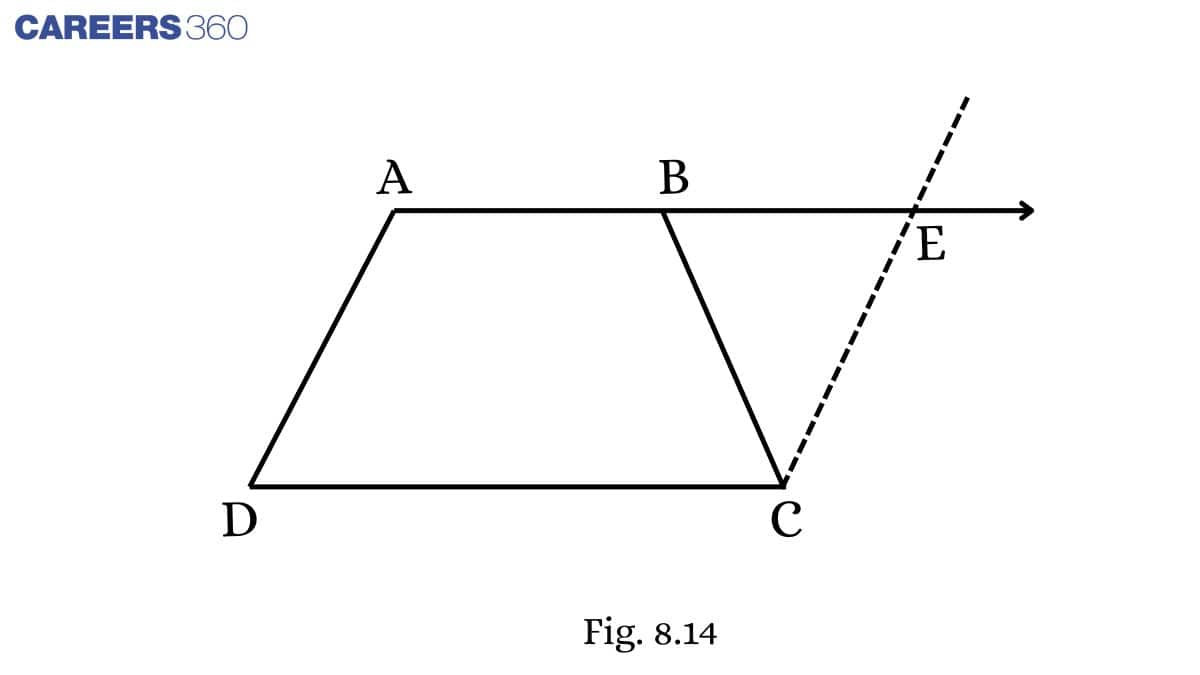
Solution:
Given: ABCD is a trapezium in which AB∥CD and AD=BC
To prove: ∠C=∠D
Proof: Let ∠ A be ∠ 1, ∠ ABC be ∠ 2, ∠ EBC be ∠ 3, ∠ BEC be ∠ 4.
∠1+∠D=180∘ (Co-interior angles)
∠2+∠C=180∘ (Co-interior angles)
∴∠1+∠D=∠2+∠C
Thus, ∠C=∠D (Since , ∠1=∠2 )
Q7 (iii) ABCD is a trapezium in which AB∥CD and AD=BC (see Fig. 8.13 ). Show that ΔABC≅ΔBAD
[Hint: Extend AB and draw a line through C parallel to DA intersecting AB produced at E.]
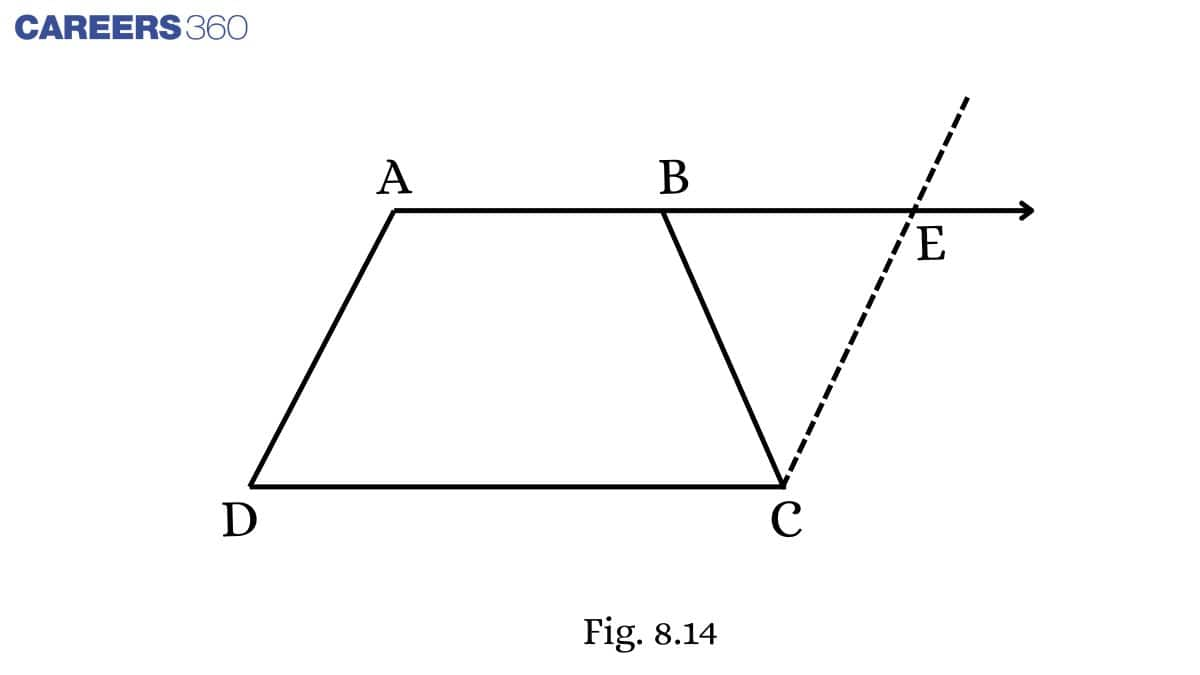
Solution:
Given: ABCD is a trapezium in which AB∥CD and AD=BC
To prove: ΔABC≅ΔBAD
Proof: In ΔABCandΔBAD,
BC = AD (Given)
AB = AB (Common)
∠ABC=∠BAD (Proved in (i))
Thus, ΔABC≅ΔBAD (By SAS rule)
Q7 (iv) ABCD is a trapezium in which AB∥CD and AD=BC (see Fig. 8.13 ). Show that diagonal AC = diagonal BD
[Hint: Extend AB and draw a line through C parallel to DA intersecting AB produced at E.]
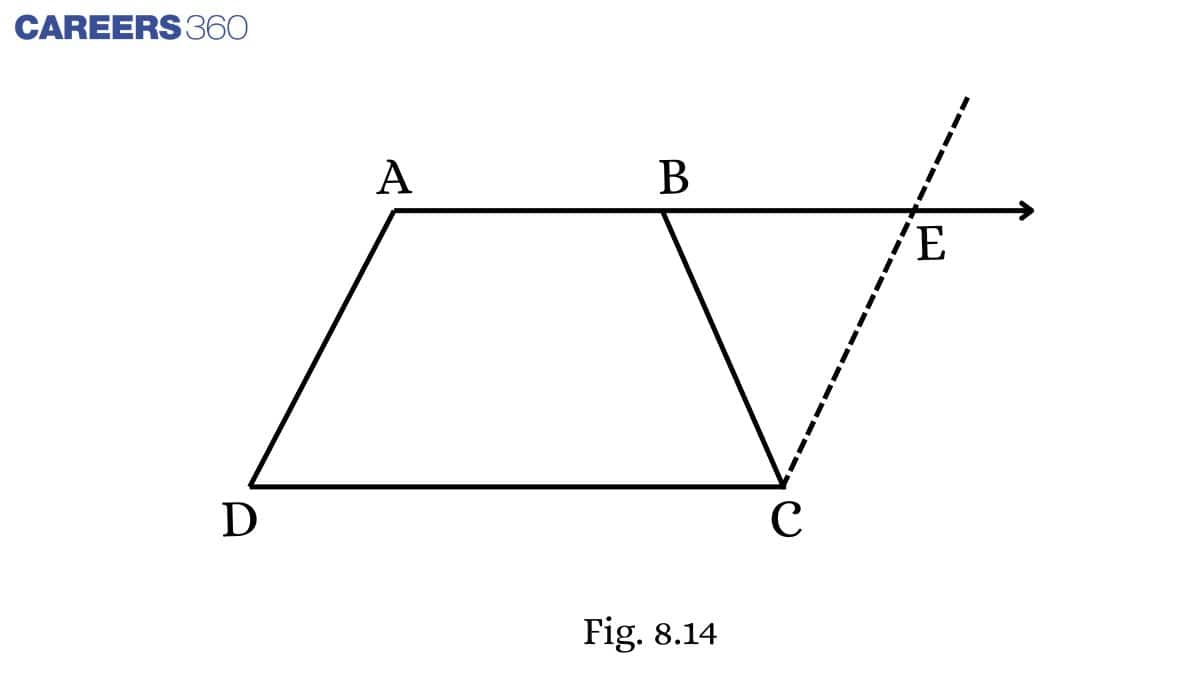
Solution:
Given: ABCD is a trapezium in which AB∥CD and AD=BC
To prove: diagonal AC = diagonal BD
Proof: In ΔABCandΔBAD,
BC = AD (Given)
AB = AB (Common)
∠ABC=∠BAD (Proved in (i))
Thus, ΔABC≅ΔBAD (By SAS rule)
diagonal AC = diagonal BD (CPCT)
Also Read
Topics covered in Chapter 8, Quadrilateral: Exercise 8.1
- Definition of a quadrilateral.
- Types of Quadrilaterals.
- Properties of Parallelograms.
- Angle sum properties
Also See
NCERT Solutions of Class 9 Subject Wise
Students must check the NCERT solutions for Class 9 Maths and Science given below:
Subject-Wise NCERT Exemplar Solutions
Students must check the NCERT exemplar solutions for Class 9 Maths and Science given below:
Frequently Asked Questions (FAQs)
The similarities between square and rhombus are:
All the sides are equal to each other
Their diagonal intersects at an angle of 90 degrees
The diagonals of a parallelogram separate it into two congruent triangles.
Quadrilateral, types of quadrilaterals and their properties and different theorem.
A quadrilateral is a closed four-sided shape formed by joining four points by straight lines.
The sum total of all angles of a quadrilateral is 360 degrees.
We can get a minimum of two triangles to form a quadrilateral.
Different types of quadrilaterals are:
Square
Rectangle
Rhombus
Trapezium
Parallelogram
Kite
Courses After 12th
Applications for Admissions are open.
As per latest syllabus. Physics formulas, equations, & laws of class 11 & 12th chapters
JEE Main Important Chemistry formulas
Get nowAs per latest syllabus. Chemistry formulas, equations, & laws of class 11 & 12th chapters
JEE Main high scoring chapters and topics
Get nowAs per latest 2024 syllabus. Study 40% syllabus and score upto 100% marks in JEE
JEE Main Important Mathematics Formulas
Get nowAs per latest syllabus. Maths formulas, equations, & theorems of class 11 & 12th chapters
